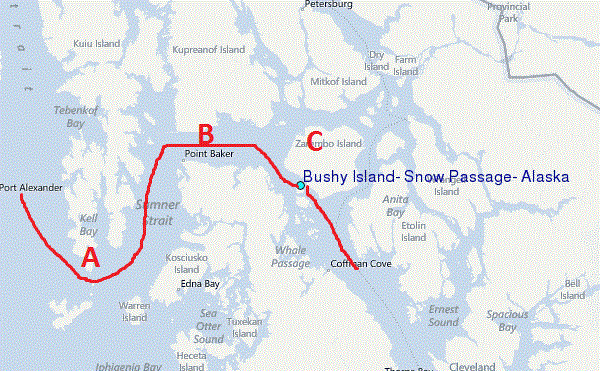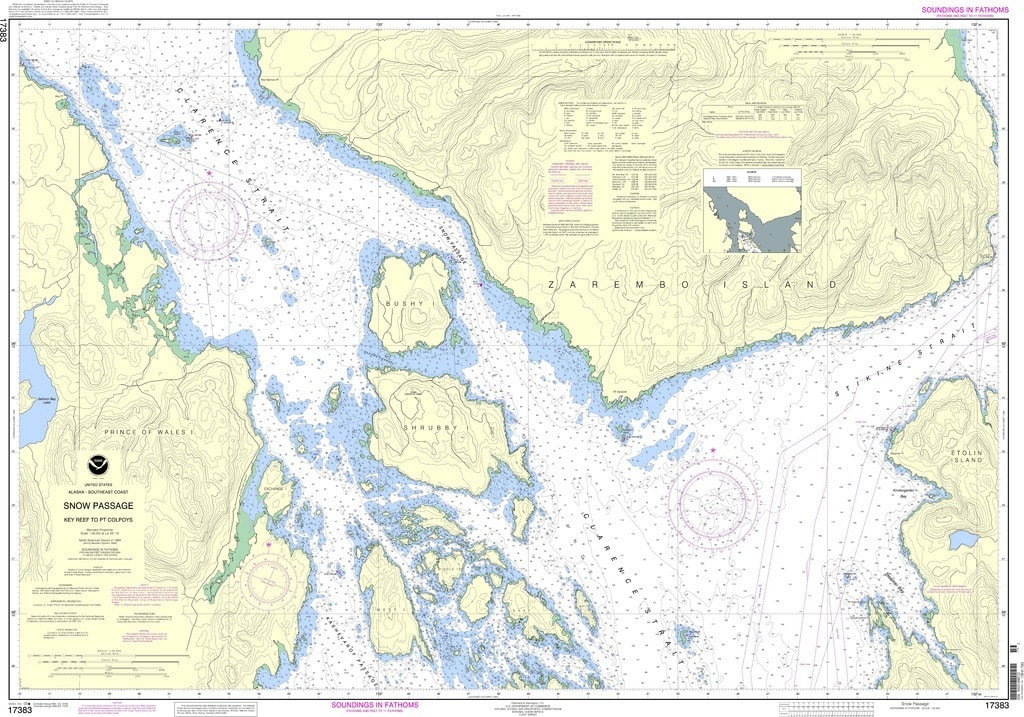Nicely on time we arrived in Ketchikan and of course that is something everybody expects. However as we sail the Inside Passage of Alaska it is not so straight forward. Between Juneau and Ketchikan we have a couple of bottle necks where the ship might have to slow down for a prolonged amount of time and then suddenly you arrive half hour our late, instead of being a little bit early.
There are three areas where there is a bigger chance of this to happen. Cape Decision, Point Baker and Snow Passage. At these three locations there is less room for a transit at full speed because there might be opposing traffic, or fishermen or wildlife (whales). Then you will have to slow down, or even stop.

Sumner Strait. Starts at Cape Decision Passage (A), then turns at Point Baker and becomes very narrow at Bushy Island Light / Snow Passage.
Cape Decision can be a challenge because you make an almost 180o turn around the Cape. The ship is coming south along the coast and then goes back up north again. Opposite traffic can do the same thing and everybody is trying to stay as close as safely possible to the cape to travel as few miles as possible. There is no vessel traffic separation here and thus the ships curve around the Cape as close as possible. At least as close as safe navigation allows. Ships and boats that go into the Pacific from here will have already set a course for their next destination and might thus be on a track of where an inbound would like to be. An inbound ship will try to stay more to the south of the Cape to avoid opposing traffic coming out which will hug the Cape. But ships going south into the Pacific might decide to go wide as well and thus meet the incoming ship. Thus opposing ships might be all over the place in the entrance and if so, it means slowing down and time delay.
Once inside the ship sails north through Sumner Strait and then has to make a 90o turn to the East at Baker Point. That 90 degree turn is not a problem, the fact that it is a fishing location can be. In the old days of the 1980’s we always had challenges here. Fishermen just ran their nets all over the place and we counted ourselves lucky that we did not tear up more nets than we did. But the indiscriminate fishing depleted the stocks and regulation was introduced and now, while the fish stocks are coming back, things are regulated a bit better. There are now specified fishing openings in various areas and the fishermen also learned that if they are sitting in the steamer track with their net, there is no insurance company that will buy them a new one. Still when the fishing fleet is there we slow down and sail by at a no –wake speed. Good for everybody but it costs time.

NOAA Chart 17383 covering Snow Passage between Sumner Strait and Clarence Strait. You can also go north of Zarembo Island but it takes a lot more time.
The last bottle neck before Ketchikan is going through Snow Passage at the south side of Zarembo Island. Looking at the chart it does not look very difficult but the challenge is the current, which can run up to 4 knots, and pushes you off your regular track line. We normally slow down here to about 14 knots, to have more time to adjust for the way the current sets, and also to have more time to curve around the buoy while being pushed over by the current. Because there is current, there is food and thus Whales like to hang out here and they go fishing in the middle of our intended track line. A 2nd reason to slow down. Give them time to recognize us and move out of the way. Then there are the fishing boats and the Tug and Tows. The tugboats normally join in and give a timely warning on the VHF that they are in the vicinity and are going to make a transit. Then the pilot on board will make arrangements which ensure that we do not meet in the middle.
Fishing boats are a different matter, there is not much fishing here, too much current, but they transit the area. They do not always adhere to the VHF protocols or hear the announcements (we see many a fisherman happily sailing by with headphones on for music) and they will go through the passage right in the middle where they know the water is the deepest. We plot them on the Radar and then we slow down even more.
These happenings are the main reason when you suddenly realize your ship did not arrive on time in Ketchikan or in Juneau if it was making a transit between these two ports. Today all was well in the world and the Zaandam arrived very timely at berth 1B and docked behind the Oosterdam, which makes a morning call here, before returning to Seattle. We even had a bit of sunshine on arrival and for Ketchikan standards that is something to cherish.

Leave a Reply